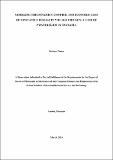| dc.description.abstract | Newcastle disease (ND) is a highly contagious viral bird disease affecting the domestic and
other wild birds. The disease is a major threat to the farming of village chicken by small,
medium, and large scale farmers.
In this dissertation, a non-linear deterministic mathematical model of ND to study the dynamics,
control and the economic loss of the village poultry with village chicken population, wild
birds population of virus in the environment is formulated and analyzed.
The basic reproduction number(R0) which represents the number of secondary cases where one
case would produce in a completely susceptible population is derived using the Next Generation
Matrix technique. The bifurcation analysis of the equilibrium points shows that a model
exhibits the forward bifurcation meaning that the R0 less than a unit is a sufficient condition
to reduce the transmission of ND in village chicken population. The sensitivity analysis of the
parameters in R0 were computed using a normalized forward sensitivity analysis, results show
that the transmission coefficient of the Newcastle disease virus between the hosts and the environment
is found to be the most positive sensitive parameter in the model.
A model is then extended to include three time dependent variables: vaccination, culling and
the environmental hygiene and sanitation control strategies. To determine the best control strategy
to mitigate the ND burden, the optimal control techniques are applied. The existence of
the optimal control problem is proved with the necessary conditions for optimality determined
using the Pontryagin’s Maximum Principle. Numerical simulations were performed using the
forward-backward sweep iterative scheme of Runge-Kutta method of order four.
Finally, a cost-effectiveness analysis is performed using the Incremental Cost-Effective Ratio
(ICER). The results showed that the vaccination control strategy indicates the lowest cost
compared to other control measures. The economic burden of the ND to chicken farmers, is
considered as the total annual expenditure that a chicken farmer can incur to rescue the at risk
chicken population from the ND is also investigated. The economic data of the model were
collected from ten villages of Bagamoyo and Kibaha, Tanzania. Results from this study indicate
that the recurrence of the ND in the village chicken population could lead to a serious
economic loss at family level in this already financially constrained environment where small
and medium farmers operate. The results obtained shows that there was 22:5% loss from their
expected profit post Newcastle outbreaks in 2017. Also the results show that the occurrence of the ND leads to an average range of 482:89 541:30$ economic loss at family in 2017.
Therefore, for the effective control of NDV and its transmission we recommend vaccination to
be paired with regular cleaning of chicken yards. | en_US |

